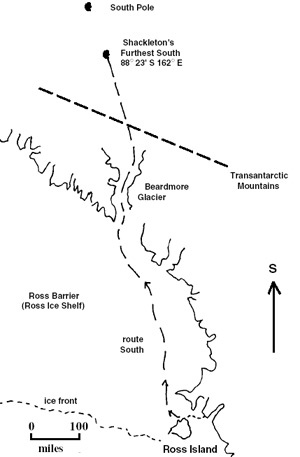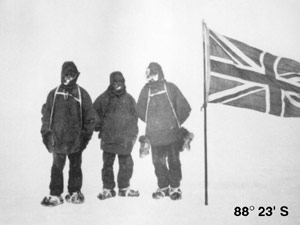
| Glasgow Digital Library | Voyage of the Scotia | BRUCE | PEOPLE | SHIP | ANTARCTIC | INDEX |
|---|

The party made good time at first on their journey south across the great ice barrier. They took 29 days to cover the distance that Scott's party had travelled in 59 days.
At 81°S the first pony had to be killed - followed on 28 November 1907 by a second, then on 2 December by a third. On 7 December a fourth pony fell into a crevasse so deep it could not be recovered, not even for its meat.
On 16 December they had reached 85°S. After Christmas Day the attainment of the South Pole was beginning to look remote as food supplies began to dwindle. The party was now on reduced rations and their body temperatures were two degrees below normal. The party was suffering from dehydration (there not being enough fuel to melt water), malnutrition and lacking the food to maintain body temperature.
On 2 January 1908 they passed the equivalent of Peary's furthest northern latitude, reaching 87°06'S. By now they had passed Scott's furthest southern latitude by 500km (300 miles). Shackleton was suffering from altitude sickness as they were now 3,350 metres (11,000 feet) above sea level. The party had discovered that the South Pole was located on the world's highest plateau.
Shackleton's furthest south was to be 88°23'S, which was 155km (97 miles) from the South Pole. They had realised that continuing would not have left enough supplies for the return to base, which was 1,170km (730 miles) away. Had they left from the Bay of Whales they might have made it to the South Pole. They turned north having beaten Scott's record by 580km (360 miles) and were 125km (79 miles) nearer to the South Pole than Peary had been to the North Pole.

Shackleton had shown the way to the heartland of the continent.
The sledge was fitted with a sail to help the journey north to their base. As none of the party had skis, the sledge tended to rush away from them. The long journey back began - through the Transantarctic Mountains and down the crevasse-filled Beardmore Glacier. There was now a rush to get back to Nimrod as the captain had been instructed to sail on 1 March, by which time the party would be assumed all dead. The condition of the men was by now extremely poor and the march north was slow. It seems that Shackleton was extremely poorly, but this did not stop him from doing his share of the work. By 79°36'S they were all suffering from dysentery.
At base camp a party set out with extra rations for the last few food dumps. This was the only time dogs were successfully used on the expedition. Shackleton had set off with 90 days' food supply - and they had now been away for 120 days. It was decided to leave a small party at Hut Point to search for Shackleton's body - but, when Nimrod arrived at Hut Point, the southern party had just arrived.
First at the South Magnetic Pole
While Shackleton was in the south, a party of three - Professor Mawson, Edgeworth David and Dr Alistair Forbes McKay reached the South Magnetic Pole after a very arduous journey in appalling conditions which involved a climb of over 2,750 metres (9000 feet.) to 72°S 155°E.
| Glasgow Digital Library | Voyage of the Scotia | BRUCE | PEOPLE | SHIP | ANTARCTIC | INDEX |
|---|